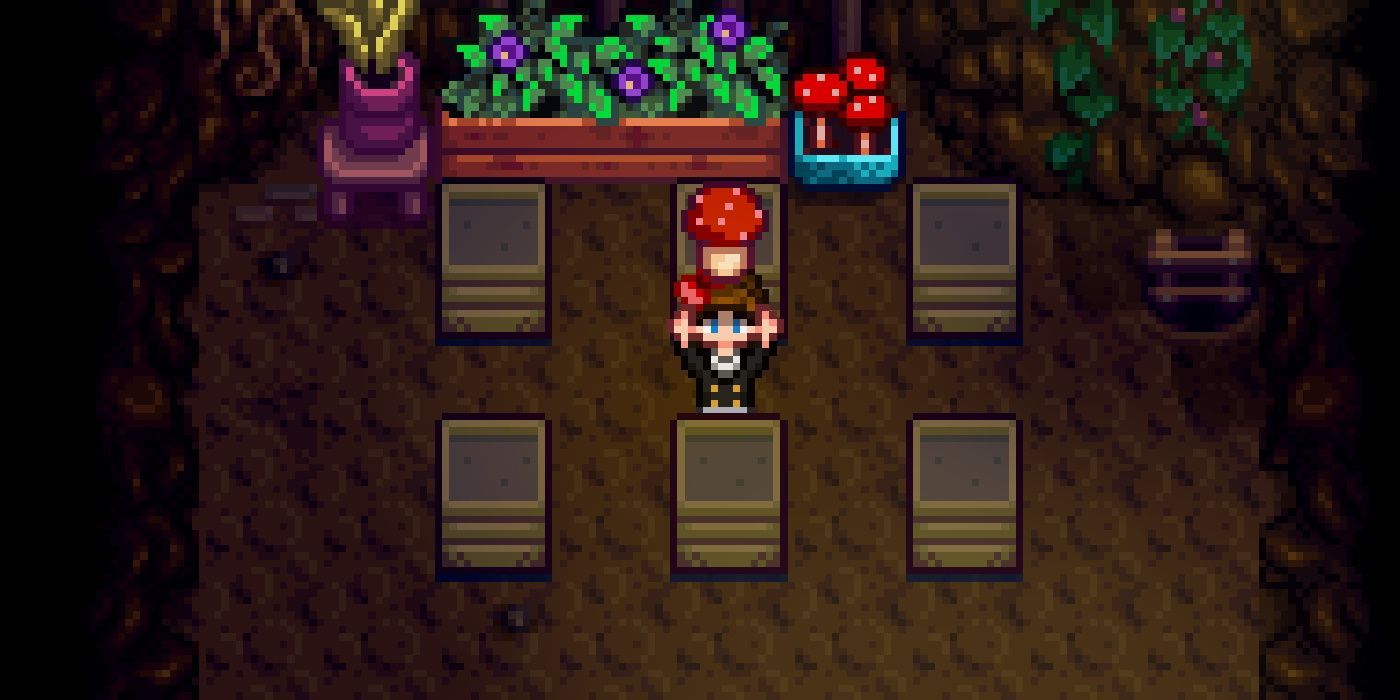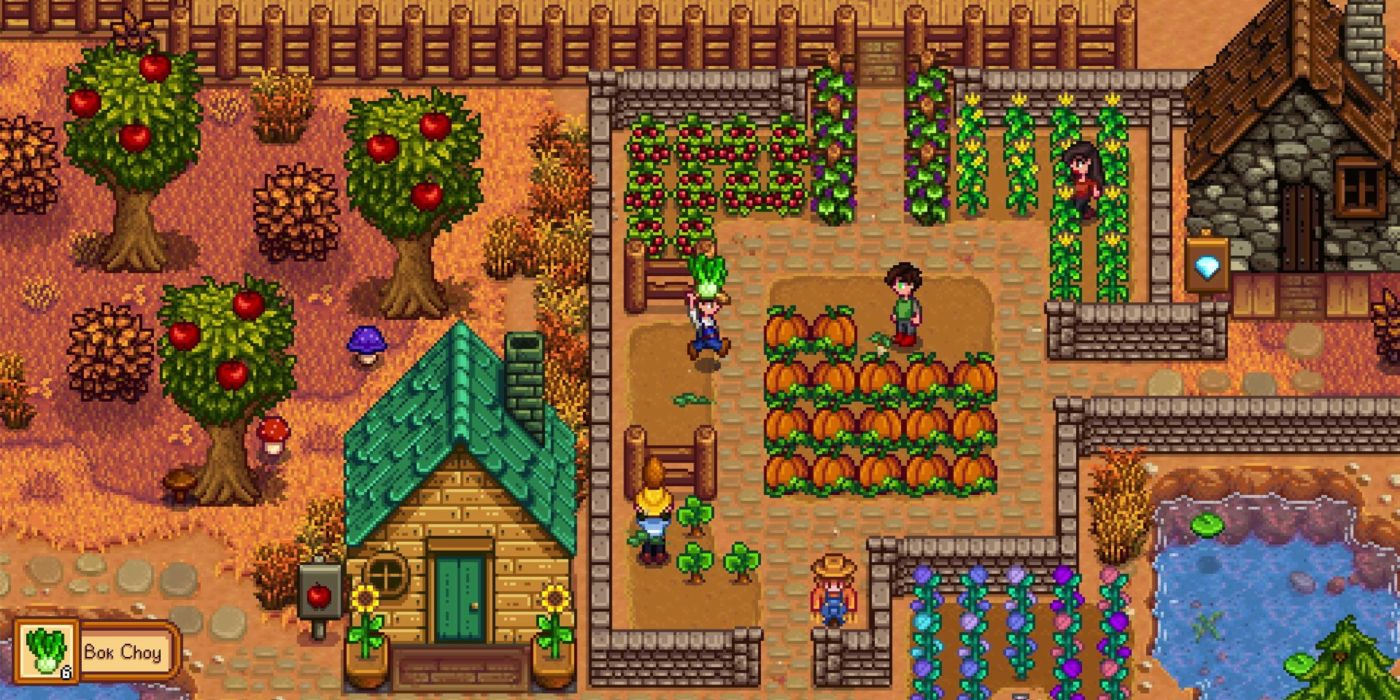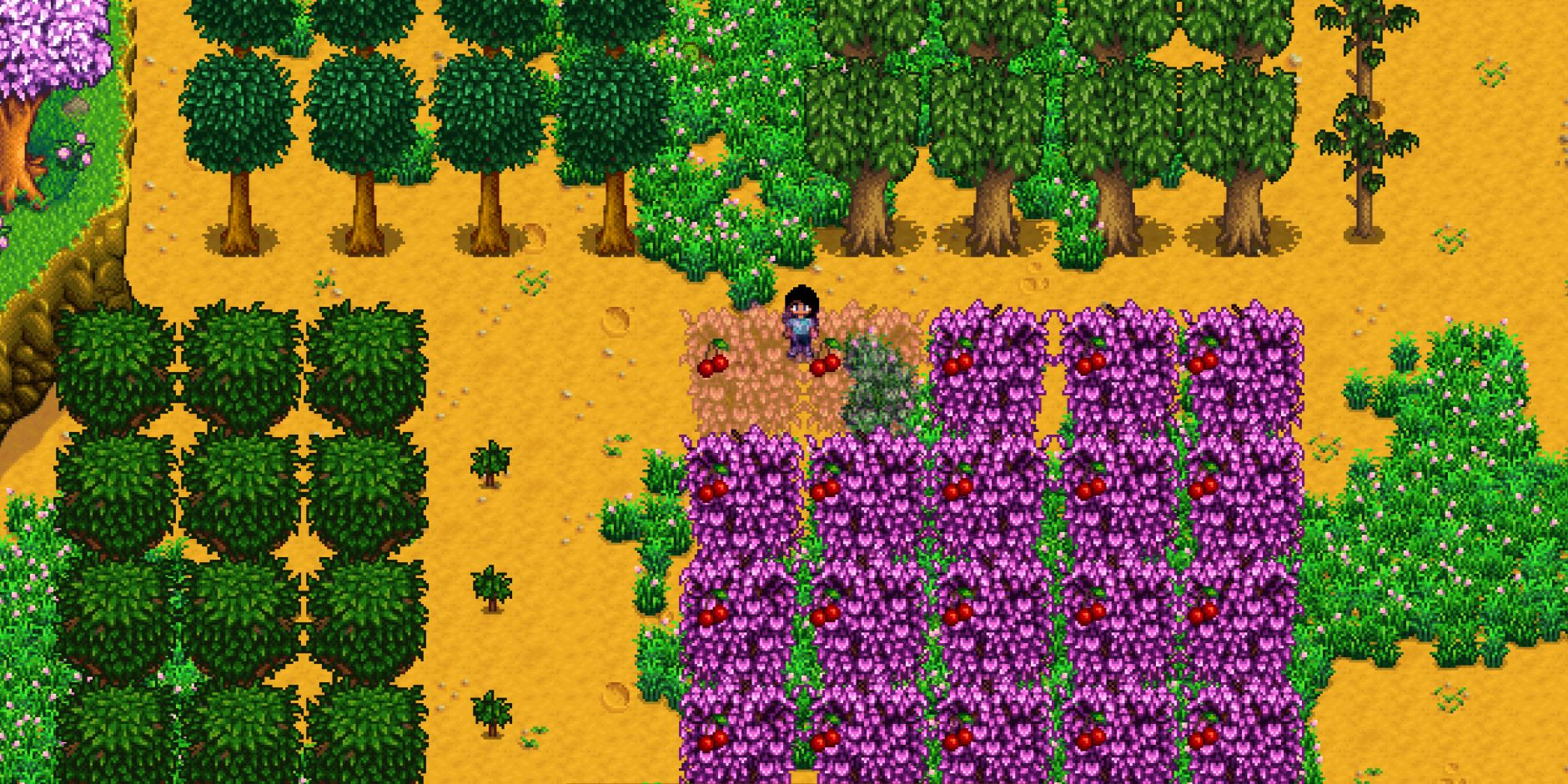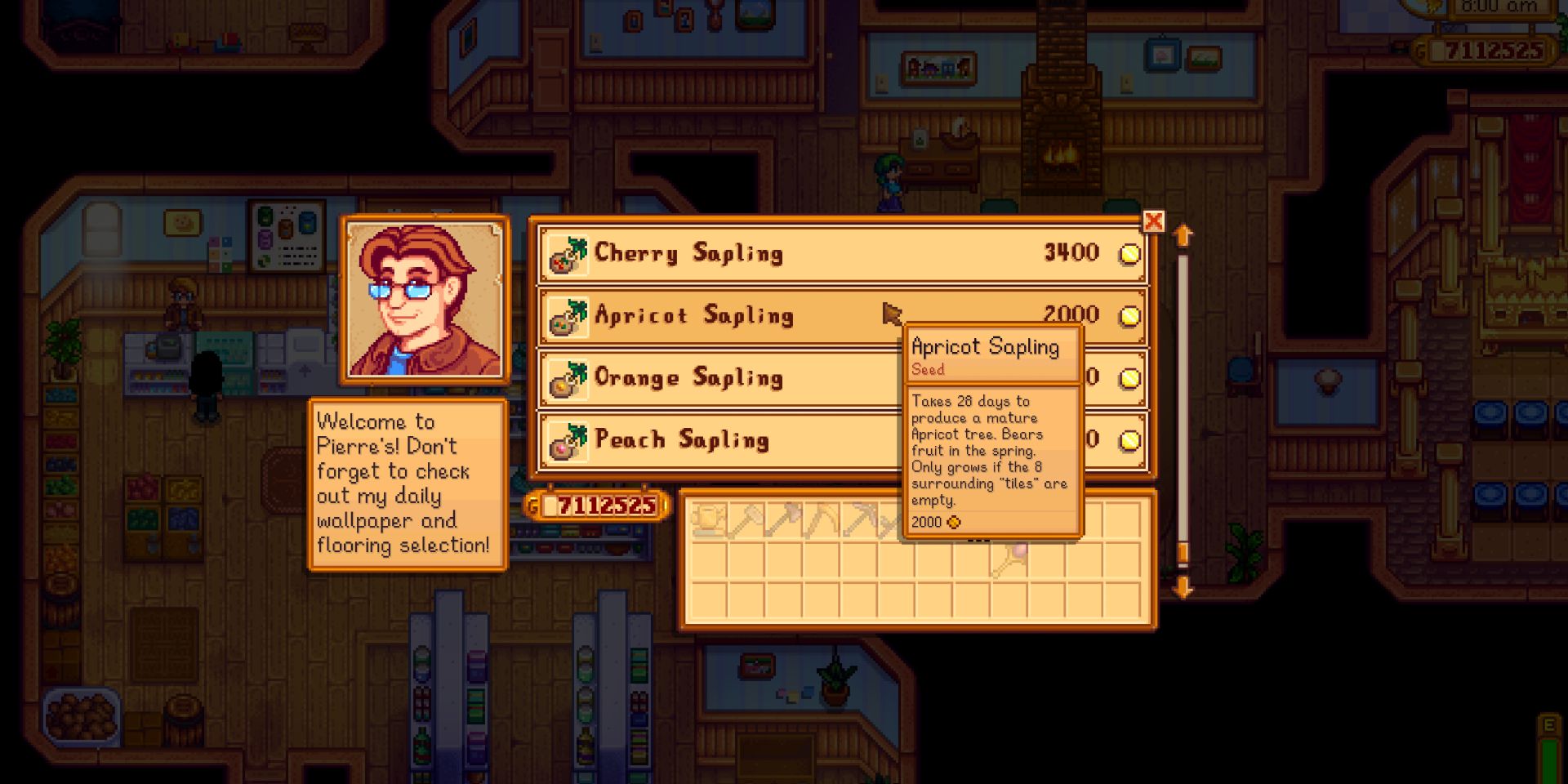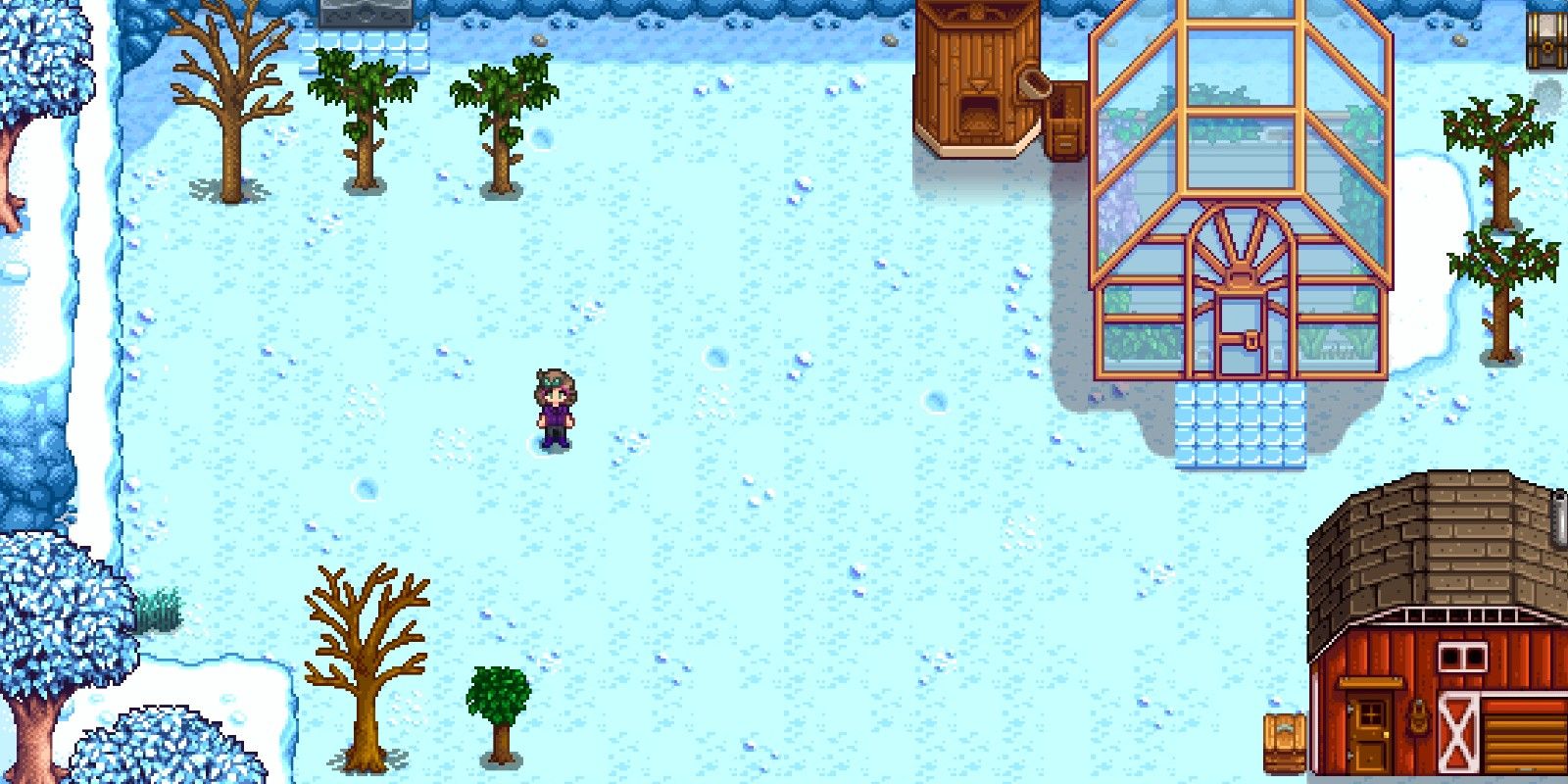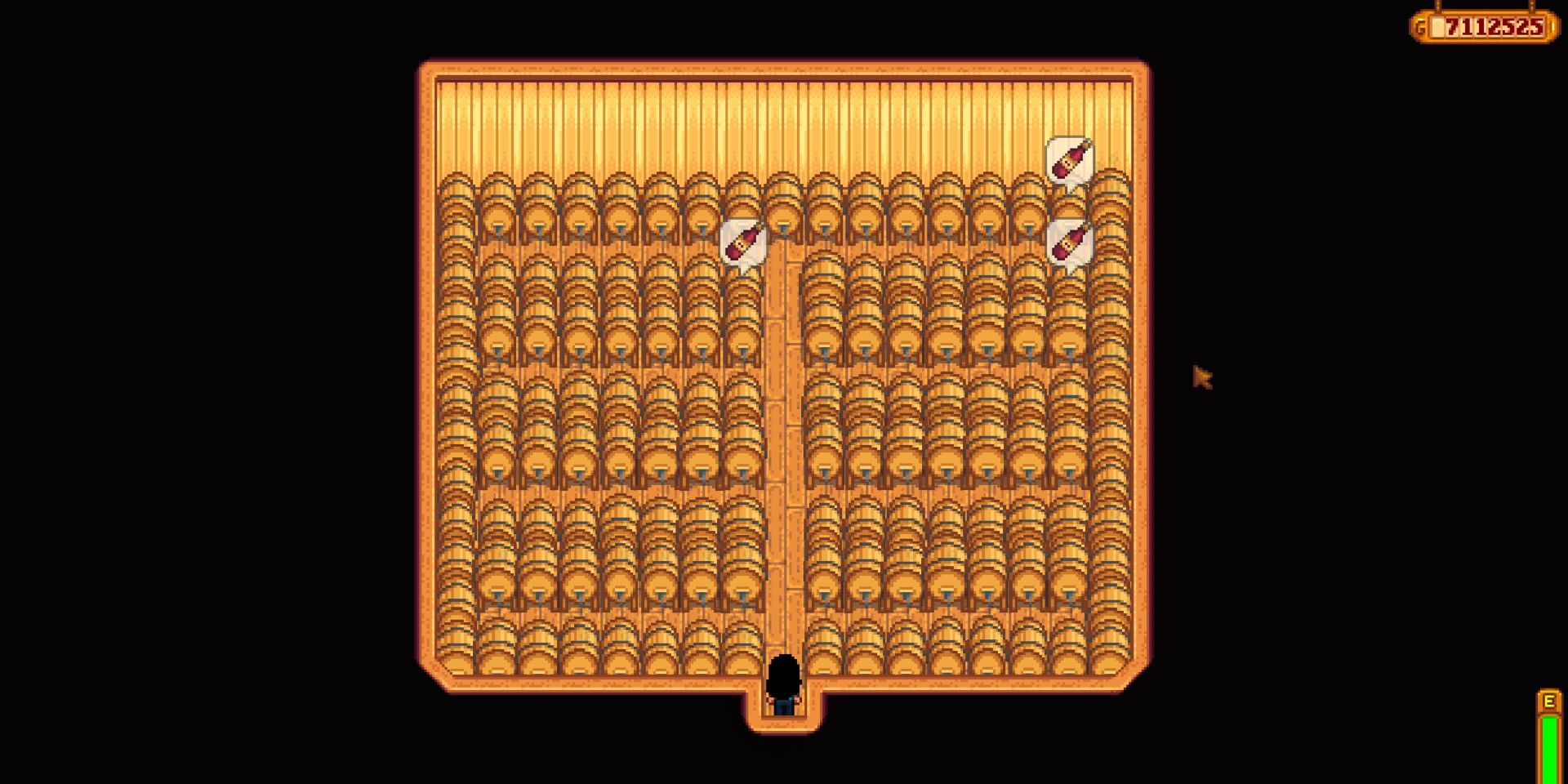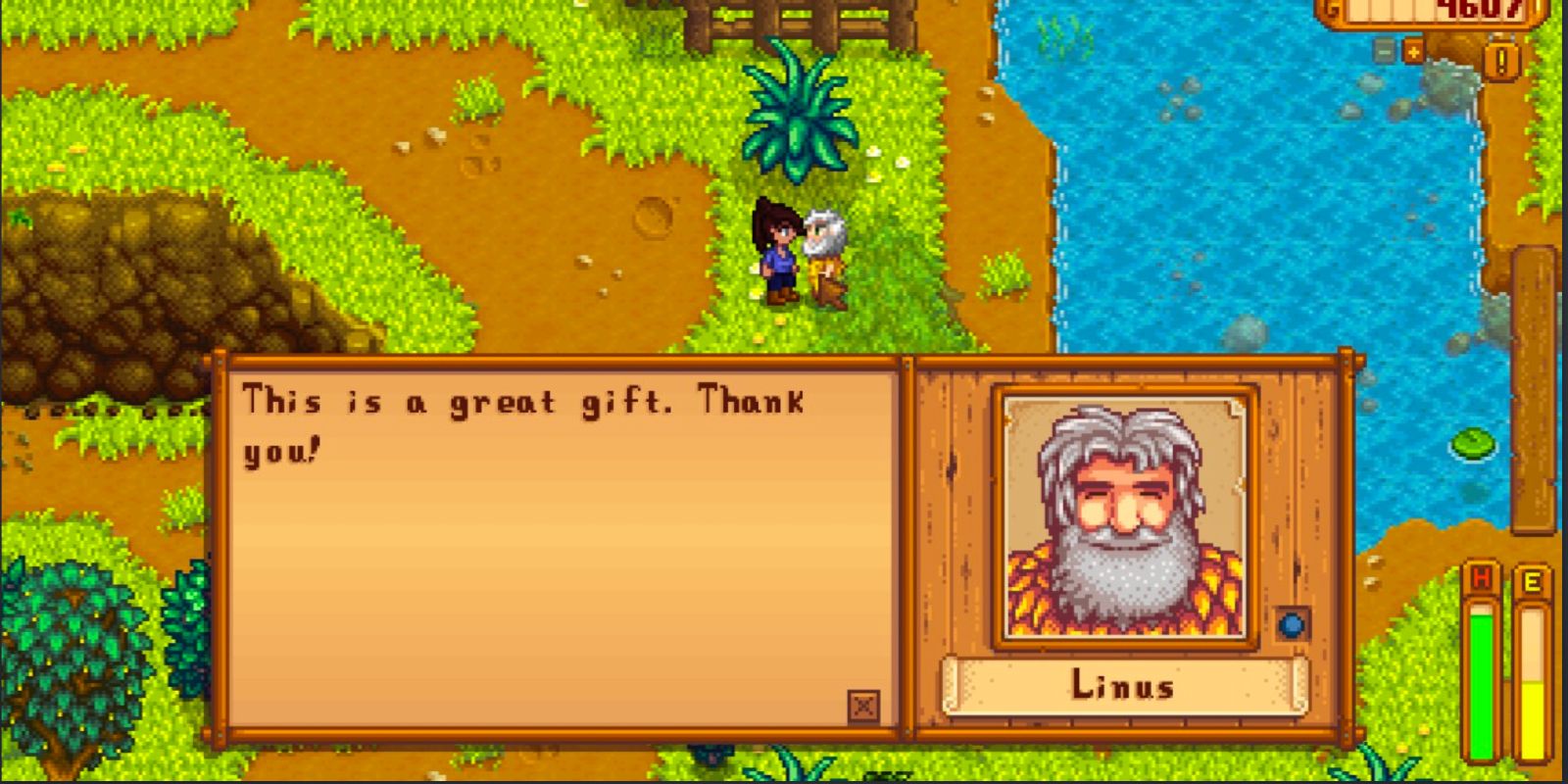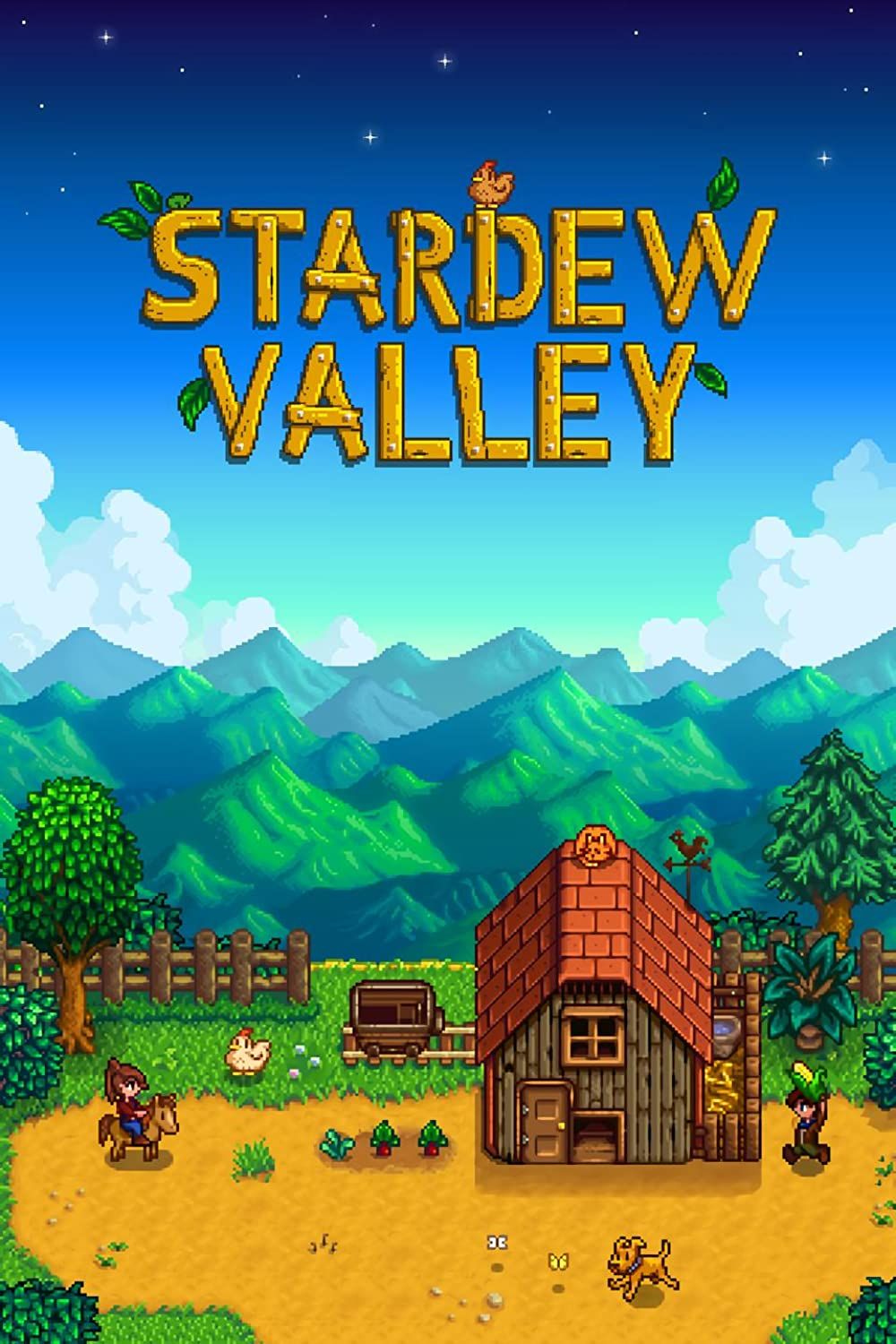Quick Links
Growing fruit trees in Stardew Valley generally isn't that high of a priority for most players. Saplings are expensive and need to grow for a long time before they can produce fruit, meaning that they require big investments of both time and money. However, it's not difficult to get those investments to pay off.
Fruits harvested from trees are not only fairly valuable, but can also be turned into highly profitable artisan goods. Planting fruit trees also means that players will have a steady supply of gifts to give villagers; nobody will turn down a fresh apple or peach. Here's everything that Stardew Valley players need to know about growing fruit trees, and utilizing their produce.
Updated March 28, 2024, by Demaris Oxman: Stardew Valley's fruit trees can be a surprisingly profitable pursuit. Some players devote entire playthroughs to creating beautiful orchards, cultivating oranges, pomegranates, and more. They can be used to create fine wine and delicious jams, and have some of the greatest monetary potential in the game. However, the mechanics of fruit trees can be a bit tricky, especially for novice farmers. What's more, the 1.6 update has introduced some minor changes to the way fruit trees function, as well as a new way of using the fruit they produce. For players who may be intimidated by growing fruit trees in Stardew Valley, here's everything you need to know.
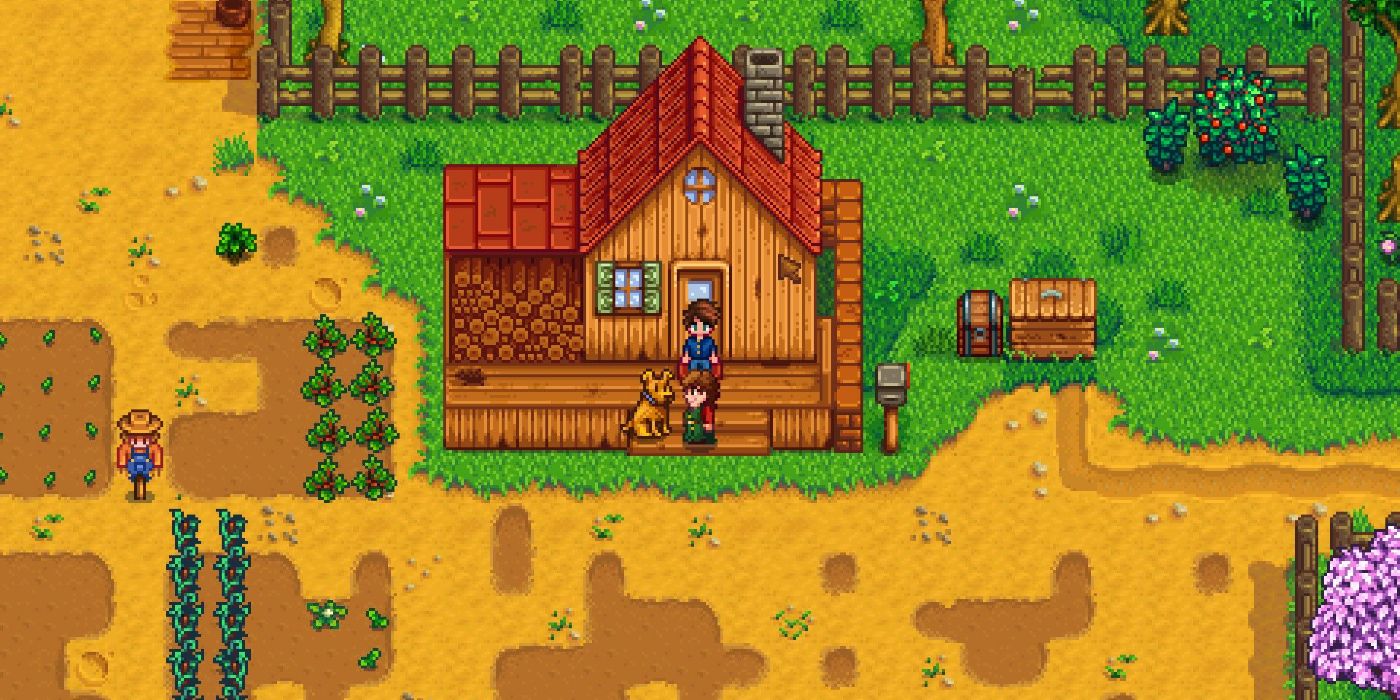
Stardew Valley: How To Get Clay
Clay is used to craft the silo and some soils in Stardew Valley, but it's not obvious how to collect large numbers of the resource.Fruit Tree Basics
There are a total of eight fruit tree types in Stardew Valley. When planted in the Greenhouse or in the tropical warmth of Ginger Island, fruit trees will produce fruit every day, regardless of the season, once they are fully grown. This makes them one of the best items to plant in those locations, as it massively increases the profit a player can make from a single tree.
When planted outdoors on the player's farm, however, each type of fruit tree has a specific harvest season. As long as they are fully grown, they will produce one fruit per day during this season.
- Spring Trees: Apricot, Cherry
- Summer Trees: Mango, Banana, Peach, Orange
- Fall Trees: Apple, Pomegranate
What's The Best Type Of Fruit Tree?
In terms of value, Bananas and their artisan goods sell for more than those of any other fruit. However, since Ginger Island isn't unlocked until later in the game, players may have awhile to wait before they can get their banana orchard started. Also, Bananas aren't as popular a gift as other tree-grown fruits. Some villagers like them, but most are neutral and some even dislike them
As far as normally purchasable fruit trees go, Pomegranates and Peaches will earn players the most money. Their saplings are the most expensive, but they will pay for themselves quickly. To top it off, not only are these fruits universally liked, but each of them has a place on a villager's Loved Gifts list: Elliot loves Pomegranates, and Robin loves Peaches.
How To Get Fruit Tree Saplings
Purchasing Saplings
Most fruit tree saplings (except for Mango and Banana) can be purchased from Pierre anytime his shop is open. His prices are:
- Apricot: 2,000g
- Cherry: 3,400g
- Orange: 4,000g
- Peach: 6,000g
- Apple: 4,000g
- Pomegranate: 6,000g
The Traveling Cart may also sell fruit tree saplings on occasion. Her prices may be lower; however, it may take several tries before the player is able to find a sapling amid her selection. The Traveling Cart proprietor's prices vary — sometimes players can get a deal here; other times, they're better off buying from Pierre.
- Apricot: 1,500g - 2,500g
- Cherry: 2,550g - 4,250g
- Orange: 3,000g - 5,000g
- Peach: 4,500g - 7,500g
- Apple: 3,000g - 5,000g
- Pomegranate: 4,500g - 7,500g
Ginger Island Saplings
Mangoes and Bananas are native to Ginger Island, and saplings for these fruit trees cannot be purchased on the mainland. Each one has approximately a 14% chance to be found inside a Golden Coconut, but there are a few other ways to find them as well.
After unlocking the Island Trader, players can purchase saplings here, although the Trader doesn't deal in typical currency. His prices are:
- 75 Mussels for a Mango Sapling. These shellfish can be foraged on beaches, or caught in Crab Pots placed in the ocean.
- 5 Dragon Teeth for a Banana Sapling. To collect these, players must venture into the Volcano Dungeon, where Dragon Teeth can be dropped by certain monsters or foraged near the skeletal remains seen throughout the caves.
Professor Snail will also award the player with saplings for helping him complete certain fossil collections:
- To get a Banana Sapling, complete the Large Animal collection.
- For a Mango Sapling, complete the Snake collection.
Growing Fruit Trees
Where, When, & How To Plant Fruit Trees In Stardew Valley
Fruit trees can be planted anywhere on the player's farm in Stardew Valley, on the Ginger Island farm, or in the greenhouse. To plant a fruit tree, select the sapling's slot in the inventory. A 3x3 grid will appear where the player hovers their mouse similar to the type of grid that appears when players are placing items or furniture on their farm. If all squares in the grid are green, the tree can be planted in the area indicated. Trees cannot be planted on tilled soil, or if there is debris in the grid area. In other words, the farmer will need a 3x3 area of clear, untilled soil to plant their tree.
Because all fruit trees take 28 days to mature, be sure to plant them no later than the first day of the season before they will bear fruit. That is, plant Spring fruit trees no later than Winter 1; Summer fruit trees no later than Spring 1; and Fall fruit trees no later than Summer 1. They will spend that season maturing, ensuring a full season of producing fruit.
Maturing Fruit Trees
While fruit trees are maturing, ensure that there is no debris in the 9-tile square surrounding the tree. This includes rocks, weeds, logs, and even forageables like truffles dug up by pigs. If the player goes to sleep while there is debris near their fruit tree, they will receive a notification in the morning, reading: "Your [fruit] tree was unable to grow last night." In gameplay terms, this means it will take one day longer for that tree to reach maturity and start producing fruit.
Unlike regular crops, fruit trees do not need to be watered. To make sure they grow properly, simply be sure to keep the square surrounding the tree clear each day. Unfortunately, there is no way to speed up their growing process, as neither Tree Fertilizer nor regular Speed-Gro will shorten the time it takes for them to mature. Players will just have to be patient.
Harvesting Fruit
When a fully matured fruit tree is in season, it will produce one fruit per day. The player can harvest this fruit by shaking the tree as they would a berry bush. Up to three fruits can stack at a time; i.e., if the player does not harvest their fruit on the first two days of a season, they can harvest three fruits on the third day. Once there are three fruits on the tree, no more will spawn until they are harvested. Thus, it is recommended that players harvest from their fruit trees at least every third day, in order for their tree to produce the maximum amount.
Note that when the season crosses over and the fruit tree's season ends, any fruit left on the tree will be lost. Thus, it is also recommended that the player harvest all remaining fruit on the last day of every season.
Fruit Quality
As a tree ages, the fruit it produces increases in quality and therefore in value. This quality increase occurs on the anniversary of the tree's first fruit harvest. The quality increases as below:
- First year of fruit: Normal quality
- Second year: Silver quality
- Third year: Gold quality
- Fourth year and beyond: Iridium quality
Coal
On rare occasions, a fruit tree may be struck by lightning during a thunderstorm. If this happens, that tree will produce coal instead of fruit for the following four days. After four days have passed, the tree will return to normal and continue producing fruit if it is in season. Any coal left on the tree that has not been harvested will disappear once the tree returns to normal.
Cutting Down Fruit Trees
As of Version 1.6, cutting down a fruit tree will result in it dropping a Sapling of the same type. For example, a Cherry Tree will drop a Cherry Sapling; an Orange Tree will drop an Orange Sapling, etc. If the tree is mature, that sapling will grow faster depending on the quality of the tree's fruit; a sapling from an Iridium-quality tree will grow the fastest. Once the sapling matures, it will produce fruit of the same quality as the tree it was cut from, and increase in quality as described above.
This essentially serves as a way for players to relocate the fruit trees on their farm, without having to purchase new saplings. The newly planted trees will still take time to grow, but this method is much less expensive than cutting down a tree and buying a new sapling to plant in a different location.
Fruit & Artisan Product Values
All fruit tree fruits fetch decent prices on their own, but they can also be placed in a Preserves Jar to make Jelly, in a Keg to make Wine, or in a Dehydrator to make Dried Fruit Below, players can find tables outlining the values of each fruit as well as the artisan products created from those fruits. (Base values are listed first, followed by the increased prices that result from the Tiller and Artisan professions if they apply.)
Five of one fruit type are required to make Dried Fruit, whereas only one is required to make Jelly or Wine. For example, 5 Apricots would normally sell for 50g each, for a total of 250g. Dried Apricots sell for 400g, or 80g for each of the Apricots required to make them. Thus, the Dehydrator is typically less profitable than the Keg or the Preserves Jar; however, Dried Fruit is a great item to restore health and energy.
Apricot
|
Item |
Normal Quality |
Silver Quality |
Gold Quality |
Iridium Quality |
|---|---|---|---|---|
|
Fruit |
50g (55g) |
62g (68g) |
75g (82g) |
100g (110g) |
|
Wine |
150g (210g) |
187g (261g) |
225g (315g) |
300g (420g) |
|
Jelly |
150g (210g) |
-- |
-- |
-- |
|
Dried Fruit |
400g (560g) |
-- |
-- |
-- |
Cherry
|
Item |
Normal Quality |
Silver Quality |
Gold Quality |
Iridium Quality |
|---|---|---|---|---|
|
Fruit |
80g (88g) |
100g (110g) |
120g (132g) |
160g (176g) |
|
Wine |
240g (336g) |
300g (420g) |
360g (504g) |
480g (672g) |
|
Jelly |
210g (294g) |
-- |
-- |
-- |
|
Dried Fruit |
625g (875g) |
-- |
-- |
-- |
Orange
|
Item |
Normal Quality |
Silver Quality |
Gold Quality |
Iridium Quality |
|---|---|---|---|---|
|
Fruit |
100g (110g) |
125g (137g) |
150g (165g) |
200g (220g) |
|
Wine |
300g (420g) |
375g (525g) |
450g (630g) |
600g (840g) |
|
Jelly |
250g (350g) |
-- |
-- |
-- |
|
Dried Fruit |
775g (1085g) |
-- |
-- |
-- |
Peach
|
Item |
Normal Quality |
Silver Quality |
Gold Quality |
Iridium Quality |
|---|---|---|---|---|
|
Fruit |
140g (154g) |
175g (192g) |
210g (231g) |
280g (308g) |
|
Wine |
420g (588g) |
525g (738g) |
630g (882g) |
840g (1,176g) |
|
Jelly |
330g (462g) |
-- |
-- |
-- |
|
Dried Fruit |
1075g (1505g) |
-- |
-- |
-- |
Apple
|
Item |
Normal Quality |
Silver Quality |
Gold Quality |
Iridium Quality |
|---|---|---|---|---|
|
Fruit |
100g (110g) |
125g (137g) |
150g (165g) |
200g (220g) |
|
Wine |
300g (420g) |
375g (525g) |
450g (630g) |
600g (840g) |
|
Jelly |
250g (350g) |
-- |
-- |
-- |
|
Dried Fruit |
775g (1085g) |
-- |
-- |
-- |
Pomegranate
|
Item |
Normal Quality |
Silver Quality |
Gold Quality |
Iridium Quality |
|---|---|---|---|---|
|
Fruit |
140g (154g) |
175g (192g) |
210g (231g) |
280g (308g) |
|
Wine |
420g (588g) |
525g (738g) |
630g (882g) |
840g (1,176g) |
|
Jelly |
330g (462g) |
-- |
-- |
-- |
|
Dried Fruit |
1075g (1505g) |
-- |
-- |
-- |
Mango
|
Item |
Normal Quality |
Silver Quality |
Gold Quality |
Iridium Quality |
|---|---|---|---|---|
|
Fruit |
130g (143g) |
162g (178g) |
195g (214g) |
260g (286g) |
|
Wine |
390g (546g) |
487g (681g) |
585g (819g) |
780g (1,092) |
|
Jelly |
310g (434g) |
-- |
-- |
-- |
|
Dried Fruit |
1000g (1400g) |
-- |
-- |
-- |
Banana
|
Item |
Normal Quality |
Silver Quality |
Gold Quality |
Iridium Quality |
|---|---|---|---|---|
|
Fruit |
150g (165g) |
187g (205g) |
225g (247g) |
300g (330g) |
|
Wine |
450g (630g) |
562g (786g) |
675g (945g) |
900g (1,260g) |
|
Jelly |
350g (490g) |
-- |
-- |
-- |
|
Dried Fruit |
1150g (1610g) |
-- |
-- |
-- |
Other Uses For Fruit Tree Fruits
Except for Mango and Banana, all tree-grown fruits in Stardew Valley are universally liked gifts. As such, having a few fruit trees on the farm ensures that players have plenty of gifts to give to anyone that they're trying to befriend. Additionally, several of them can be used in bundles for the Community Center:
- Fodder Bundle: 3 Apples
- Enchanter's Bundle: 1 Pomegranate
- Artisan Bundle: All fruit tree fruits (except for Mango and Banana) are among the variety of options for the six items required for this bundle.
